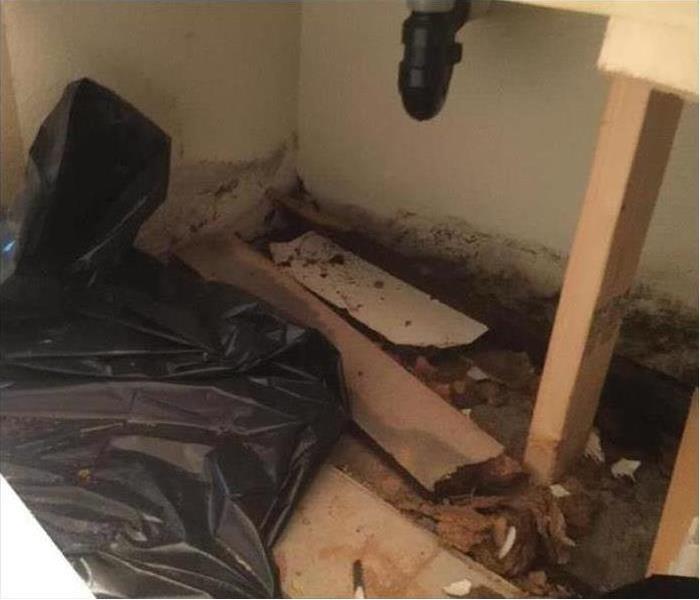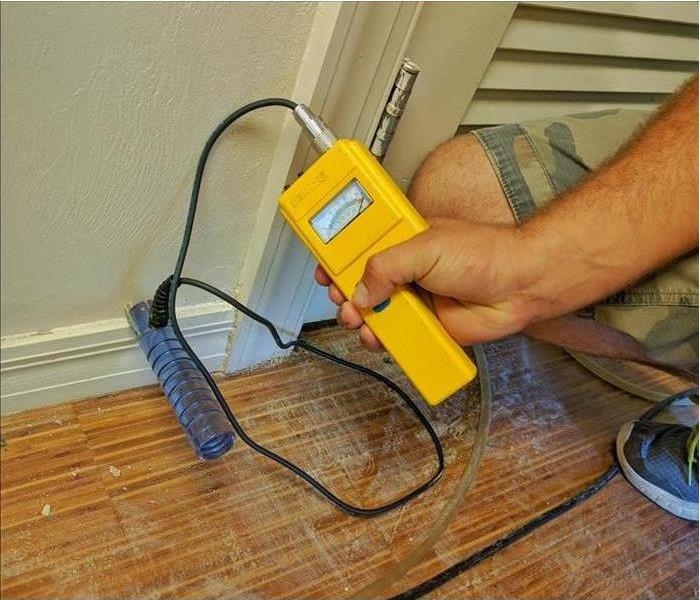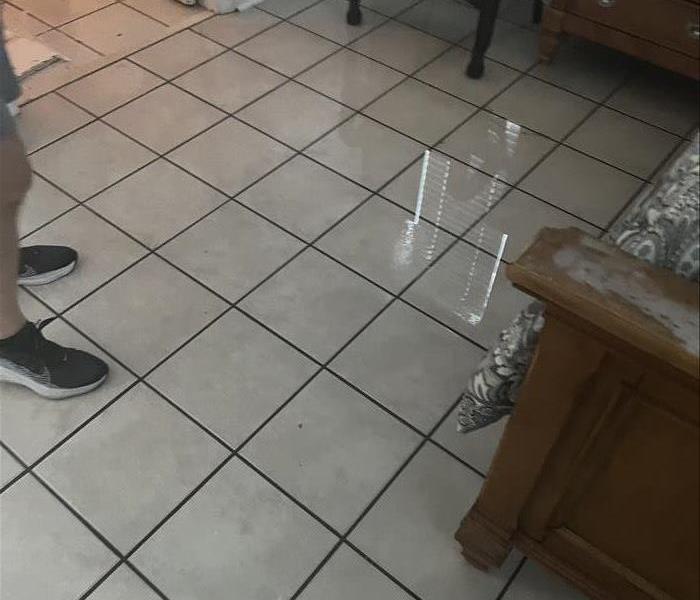Recent Water Damage Posts
Water Damage in Maitland, Florida: What You Need to Know
7/1/2024 (Permalink)
When it comes to living in Florida, water damage is a common issue that homeowners frequently confront. From hurricanes and tropical storms to daily thunderstorms, the state’s weather conditions are a leading cause of water damage affecting many homes. Maitland, Florida, is not immune to these challenges. At SERVPRO®, we understand the intricacies of dealing with water damage and offer quality services to restore your property quickly and efficiently.
Understanding Water Damage in Florida
Water damage can be a devastating problem with far-reaching consequences. Whether it results from natural disasters or domestic issues, understanding water damage is the first step towards addressing it effectively.
Common Causes of Water Damage
Several factors can lead to water damage in Florida, including:
- Tropical Storms and Hurricanes: These severe weather events bring heavy rain and high winds, causing flooding and structural damage.
- Plumbing Issues: Leaky pipes, broken water heaters, and malfunctioning appliances contribute to indoor water damage.
- Roof Leaks: Florida's frequent rainstorms can expose weaknesses in your roof, leading to leaks and water intrusion.
- Flooding: Low-lying areas in Maitland are particularly prone to flooding during intense storms.
- Sewage Backups: Blockages and broken sewage lines can result in water backing up into your home.
The Impact of Water Damage
Water damage doesn't just affect the physical structure of your home; it can also have significant health and financial implications.
Health Risks
Water damage can lead to mold growth, which poses several health risks:
- Allergic Reactions: Mold can trigger allergies in sensitive individuals.
- Respiratory Issues: Prolonged exposure to mold can lead to asthma and other respiratory conditions.
- Infection Risks: Stagnant water can harbor bacteria and other pathogens that may cause infections.
Financial Costs
The longer water damage goes unaddressed, the higher the repair costs:
- Structural Repairs: Water can weaken walls, floors, and ceilings, requiring extensive repairs.
- Mold Remediation: Removing mold is a costly but necessary process.
- Furniture and Appliance Replacement: Water damage can ruin furniture, electronics, and appliances.
Immediate Steps to Take After Water Damage
When water damage occurs, quick action is essential to minimize the damage and start the restoration process.
Essential Actions
- Safety First: Ensure that everyone is safe. Turn off the electricity and avoid walking through standing water.
- Identify the Source: Locate and stop the source of water to prevent further damage.
- Document the Damage: Take photos and videos of the affected areas for insurance purposes.
- Contact Professionals: Reach out to water damage restoration experts like SERVPRO Maitland for immediate assistance.
The SERVPRO Maitland Restoration Process
At SERVPRO Maitland, we follow a proven restoration process to ensure your home is restored to its pre-damage condition as quickly as possible.
Inspection and Assessment
Our team conducts a thorough inspection to assess the extent of the water damage. We use advanced moisture detection equipment to identify all affected areas.
Water Removal
Using powerful pumps and vacuums, we quickly remove standing water from your property. This step is crucial to prevent further damage and mold growth.
Drying and Dehumidification
We employ industrial-grade fans and dehumidifiers to dry out your property completely. Our equipment ensures that no moisture is left behind, reducing the risk of mold development.
Cleaning and Sanitizing
All affected surfaces are cleaned and sanitized to eliminate any harmful bacteria and prevent mold growth. We also clean and restore any salvageable items.
Restoration
Our final step involves repairing and restoring your home to its original condition. This may include fixing damaged walls, floors, and ceilings, and replacing ruined materials.
Why Choose SERVPRO Maitland?
When it comes to dealing with water damage in Florida, choosing a reliable restoration company is vital. Here’s why SERVPRO Maitland stands out:
- Experience: With years of experience, our team has the expertise to handle any water damage scenario.
- Advanced Technology: We use state-of-the-art equipment for detection, removal, and drying.
- 24/7 Availability: Water damage can happen anytime, so our services are available 24/7 for emergencies.
- Comprehensive Services: From initial assessment to full restoration, we offer a wide range of services to meet your needs.
- Customer Satisfaction: Our primary goal is to ensure you are satisfied with our work and that your home is safe and restored.
Conclusion
Water damage in Florida is a common, yet serious issue that requires immediate attention and expert handling. At SERVPRO Maitland, we understand the challenges that water damage presents and are committed to providing top-notch restoration services. If you are dealing with water damage in Maitland, Florida, contact us today, and let us help you restore your home to its original condition. Remember, acting quickly can save you time, money, and stress in the long run.
Protecting Your Property: A Guide to Water and Storm Damage
6/11/2024 (Permalink)
Florida, with its picturesque beaches and year-long sunshine, is nothing short of paradise. However, this beautiful state is also on nature's frontline. Its residents and businesses are no strangers to unpredictable weather patterns, including the havoc caused by storms. As a property owner or manager, safeguarding your investment is crucial. Today, we will dive deep into understanding water and storm damage, the essential steps to tackle it, and why hiring commercial general contractors in Orlando, Florida can be a game-changer.
The Wrath of Water and Storm Damage
Storms bring with them high winds, torrential rain, and flooding. In Orlando, commercial properties are as susceptible to damage as residential ones. When water seeps into buildings, it doesn't just leave a wet trail – it can lead to mold growth, structural damage, and a host of other problems that compromise the safety and usability of a commercial space.
The aftermath of water and storm damage is often overwhelming. Business owners might find themselves dealing with broken windows, damaged roofs, soggy interiors, and a halt in operations. Not only does this impact the physical structure, but the disruption can also lead to a loss in revenue and productivity.
Critical First Steps Post-Storm
- Safety First: Before anything else, ensure the safety of all individuals. Evacuate the premises if necessary. It's always wise to wait for official clearance so that it's safe to return.
- Assessment: Conduct a thorough assessment of the damage. Documenting this – with photos and videos – can be invaluable when filing insurance claims. Don't start any cleaning or repairs before your insurance company has conducted their inspection.
- Water Removal and Drying: Standing water is the number one enemy post-storm. Engage professionals who specialize in water extraction and drying. The faster you address this, the lesser the damage. Maitland water damage restoration specialists are particularly adept at this, ensuring minimal interruption to business operations.
- Preventive Measures: After dealing with immediate dangers, it's time to consider preventive measures. This includes reinforcing windows, ensuring roofs are in top condition, and installing storm shutters. Regular maintenance and checks can save enormous costs in the long run.
The Role of Commercial General Contractors in Orlando, Florida
When it comes to significant repair and restoration, partnering with experienced Orlando commercial general contractors is pivotal. Here's why:
- Expertise and Resources: Commercial general contractors bring a wealth of experience to the table. They understand the nuances of different types of buildings and the best materials to use for repairs. Their extensive knowledge ensures that the restoration is done correctly and sustainably.
- Efficiency and Speed: Time is of the essence after a storm. Every hour counts when it comes to mitigating damage and getting back to business. Professional contractors have the manpower and equipment to expedite the process, ensuring that your commercial space is restored swiftly and efficiently.
- Comprehensive Services: From initial assessment to reconstruction, commercial general contractors offer end-to-end solutions. They handle everything – from minor repairs to major renovations, giving business owners peace of mind.
- Compliance and Standards: Reputable contractors ensure that all repairs and rebuilds meet local codes and standards. This compliance safeguards against future liabilities and ensures the durability of the work done.
- Insurance Coordination: Navigating insurance claims can be daunting. Contractors often assist in preparing documentation, understanding coverage, and even liaising with insurance adjusters to ensure fair compensation.
Community and Collaboration
Florida's close-knit communities thrive on collaboration. Business owners can benefit greatly from staying connected with local networks that share information and resources about preventing and addressing storm damage. Partnering with firms that have a deep understanding of the local landscape, like those specializing in storm damage in Orlando, FL, ensures personalized and efficient service.
Moreover, investing in relationships with contractors means that when a storm does strike, you already have a trusted team to call upon. Regularly updating these professionals on your property's status ensures they have the most accurate information to act swiftly in emergencies.
Conclusion
Water and storm damage are inevitable challenges for commercial property owners in Florida. However, with the right preparations and partnerships, the fallout can be effectively managed. Engaging trusted Orlando commercial general contractors and experts in Maitland water damage restoration ensures that businesses can bounce back with resilience. Proactive measures, timely responses, and a community-first approach can transform storm crises into opportunities for strengthening infrastructure and fortifying business operations against future calamities.
Why Choose SERVPRO® for Water Damage from a Broken Pipe
1/21/2024 (Permalink)
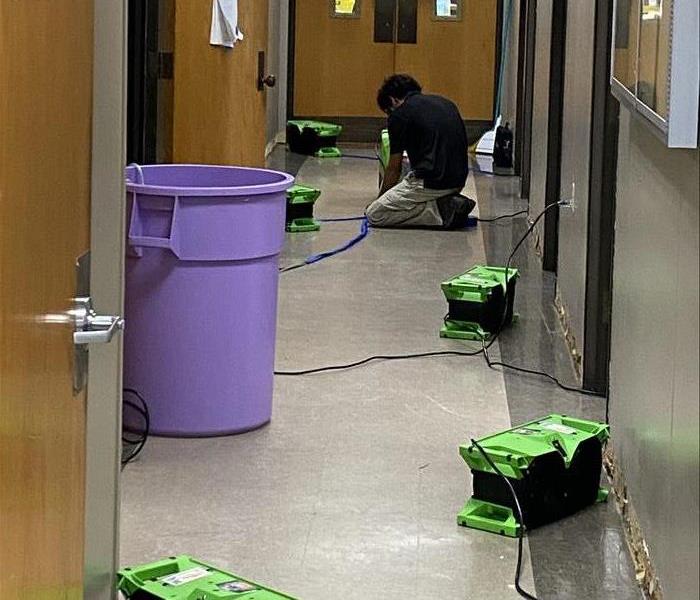 SERVPRO equipment being used to treat water damage
SERVPRO equipment being used to treat water damage
Water damage can strike homes and workplaces unexpectedly, often caused by broken or burst pipes. When faced with this challenging situation, it's crucial to act quickly and efficiently to minimize damage and prevent further issues. Here's why you should consider SERVPRO when your property sustains water damage from a broken pipe.
1. Rapid Response: Water damage requires immediate attention. SERVPRO understands the urgency and provides 24/7 emergency services. Our quick response helps prevent further damage and mold growth.
2. Expertise: With years of experience and a team of highly trained professionals, SERVPRO specializes in water damage restoration. We have the knowledge and equipment to handle water damage of all sizes and complexities.
3. Comprehensive Assessment: Our experts conduct a thorough assessment of the water damage to determine the extent and severity. This assessment guides our restoration plan, ensuring no detail is overlooked.
4. Advanced Equipment: SERVPRO employs state-of-the-art equipment, including moisture detection tools, industrial-grade pumps, and drying equipment, to remove excess water and restore your property efficiently.
5. Mold Prevention: Water damage can lead to mold growth if not handled properly. SERVPRO takes steps to prevent mold by thoroughly drying affected areas and applying antimicrobial treatments when necessary.
6. Restoration vs. Replacement: We focus on restoration rather than replacement whenever possible, which can save you time and money. Our goal is to return your property to its pre-damage condition.
7. Insurance Liaison: Dealing with insurance claims can be overwhelming. SERVPRO can work directly with your insurance company to streamline the claims process, ensuring a smoother experience for you.
8. Customer Satisfaction: Our commitment to customer satisfaction is unwavering. We aim to exceed your expectations by delivering top-quality service and maintaining open communication throughout the restoration process.
9. Local Presence: SERVPRO is a trusted and respected name in the community. We have a local presence, allowing us to respond quickly to your water damage emergency.
10. Peace of Mind: When you choose SERVPRO, you're choosing peace of mind. We handle every aspect of the water damage restoration process, from assessment to cleanup and restoration, so you can focus on getting your life or business back on track.
When water damage strikes your home or workplace due to a broken pipe, you don't have to face it alone. SERVPRO is here to provide professional, reliable, and efficient water damage restoration services, helping you restore your property "Like it never even happened." Contact us 24/7 to make water damage a thing of the past.
Click Here for more information on hazards from water damage.
Roof Leaks and Water Damage: The Threat of Mold Growth
1/5/2024 (Permalink)
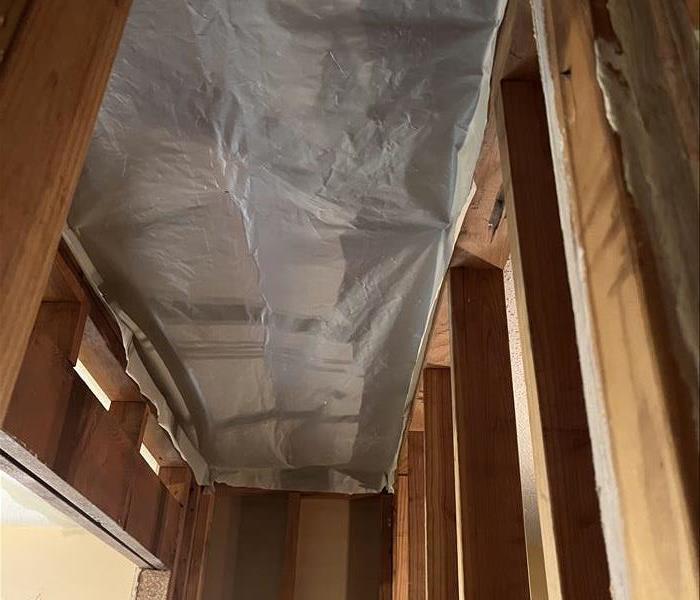 Ceiling area being treated for water damage
Ceiling area being treated for water damage
Roof leaks can be a homeowner's nightmare, and they often bring more than just immediate structural concerns. Beyond the visible damage, the hidden danger of mold growth lurks, ready to cause further havoc in your home. In this blog post, we'll delve into the dangers of water damage from roof leaks and the potential for mold growth, along with how SERVPRO® can help mitigate these risks.
The Hidden Menace: Mold Growth
Roof leaks introduce moisture into your home's interior, creating an environment conducive to mold growth. Here's how it happens:
Moisture Intrusion: When your roof leaks, water can seep into your attic, walls, or ceiling, often going unnoticed until it causes visible damage or unpleasant odors.
Ideal Conditions: Mold spores are ever-present in the air, but they require moisture to grow. A damp, dark, and humid environment is a perfect breeding ground for mold.
Rapid Multiplication: Once mold spores find a suitable environment, they can begin to multiply within 24 to 48 hours.
The Dangers of Mold Growth
Mold growth is not just an aesthetic issue; it poses significant health and structural risks:
Health Hazards: Mold can trigger allergies and respiratory problems, causing symptoms such as coughing, sneezing, and wheezing. Prolonged exposure can be particularly harmful, especially for individuals with allergies, asthma, or compromised immune systems.
Structural Damage: Mold can cause structural damage to your home. It can deteriorate drywall, insulation, wood, and other building materials, potentially leading to costly repairs.
Odor and Aesthetics: Mold growth is accompanied by a musty odor that can permeate your living space. Additionally, mold can stain walls and ceilings, affecting your home's aesthetics.
Mitigating Mold Growth after Roof Leaks
Preventing mold growth after roof leaks is crucial to protecting your home and health:
Address the Roof Leak: First and foremost, fix the roof leak to prevent further water intrusion.
Quick Response: Act promptly when you notice signs of water damage, such as stains or discoloration on walls or ceilings.
Professional Help: Contact SERVPRO® for professional water damage restoration. Here's why:
a. Expertise: Our certified technicians are trained to assess the extent of water damage and mold growth, creating a comprehensive restoration plan.
b. Advanced Equipment: We use advanced equipment for water extraction, drying, and dehumidification, ensuring thorough and efficient restoration.
c. Mold Remediation: If mold growth is detected, SERVPRO® offers professional mold remediation services to safely and effectively remove mold from your home.
d. Preventative Measures: Our quick response and drying techniques help prevent further mold growth, safeguarding your property and health.
Conclusion
Roof leaks are not just a structural concern; they can lead to the insidious threat of mold growth. Recognizing the dangers of water damage and mold is essential for homeowners. SERVPRO® is your trusted partner in mitigating these risks. With our expertise, state-of-the-art equipment, and commitment to mold prevention, we'll help restore your property to its pre-leak condition and ensure it remains a safe and mold-free environment. Don't hesitate to contact SERVPRO® at the first sign of roof leaks or water damage to protect your property, your health, and your peace of mind.
Click Here for more information on mold growth from water damage.
Why SERVPRO® Experts Are Your Best Choice for All Commercial and Residential Water Damage Events
12/28/2023 (Permalink)
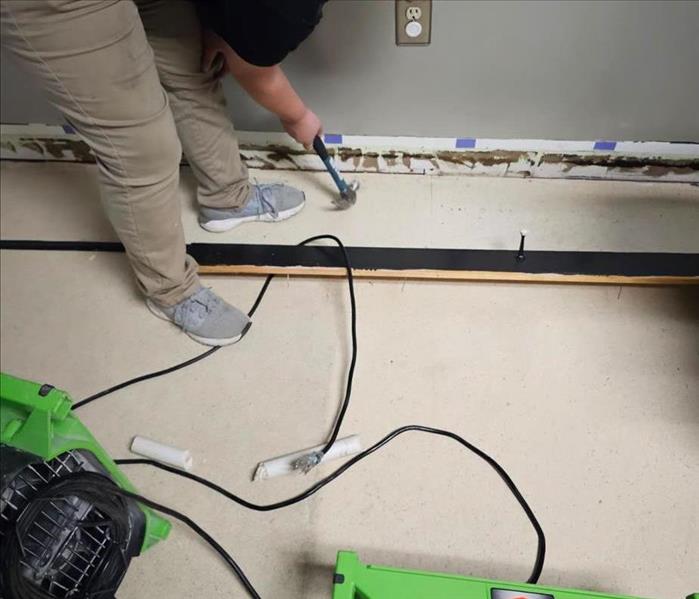 SERVPRO expert during water damage restoration job
SERVPRO expert during water damage restoration job
Water damage is a formidable foe that can strike unexpectedly, causing significant damage to both commercial and residential properties. When water damage occurs, it's essential to have a reliable and experienced team by your side. In this blog post, we'll explore why the experts at SERVPRO® should be your first call for any and all water damage events.
1. Rapid Response:
Water damage doesn't adhere to a schedule; it can happen at any time. SERVPRO® understands the urgency of water damage situations and offers a 24/7 rapid response service. Our experts are ready to mobilize immediately, day or night, to mitigate the damage and prevent further issues.
2. Comprehensive Services:
Whether it's a burst pipe, flooding, roof leaks, or any other water-related disaster, SERVPRO® offers a wide range of services designed to address both residential and commercial water damage. From water extraction and drying to mold remediation and content restoration, our experts provide comprehensive solutions tailored to your unique needs.
3. Industry Experience:
Our SERVPRO® experts are highly trained and certified in water damage restoration. With years of experience under their belts, they possess the knowledge and expertise to assess the extent of the damage accurately, develop a comprehensive restoration plan, and execute it with precision.
4. Cutting-Edge Technology:
SERVPRO® stays at the forefront of the restoration industry by investing in state-of-the-art equipment and technology. Our advanced tools, such as industrial-strength pumps, moisture meters, and high-capacity drying systems, enable us to efficiently remove water, thoroughly dry affected areas, and restore your property to its pre-damage condition.
5. Mold Prevention and Remediation:
One of the primary concerns after water damage is the potential for mold growth. SERVPRO® takes proactive steps to prevent mold issues and can remediate any existing mold problems. We ensure that your property is not only dry but also safe and mold-free.
6. Insurance Coordination:
Dealing with insurance claims can be a complex process. SERVPRO® experts can assist in coordinating the insurance process, working with your insurance company to ensure a smoother and more efficient claims experience. This reduces the stress and burden on your end.
7. Trusted Reputation:
SERVPRO® has built a strong reputation in the restoration industry, known for its commitment to quality and customer satisfaction. Our community testimonials and referrals attest to the trust and confidence that property owners place in our services.
Conclusion:
When faced with a water damage event in your home or business, you can trust the experts at SERVPRO® to provide immediate and comprehensive assistance. With our rapid response, industry experience, cutting-edge technology, and dedication to excellence, we have the expertise needed to handle any water damage situation. Count on SERVPRO® to restore your property efficiently and professionally, ensuring your peace of mind.
For information on flooding and water damage Click Here
Reclaiming Sunshine State Splendor: SERVPRO's Orlando, FL Water Damage Expertise
11/6/2023 (Permalink)
In the heart of Orlando, Florida, where the enchantment of theme parks meets the unpredictability of weather, water damage can pose a challenge for homeowners. Whether it's a sudden downpour, a plumbing mishap, or a roof leak, the impact of water damage can be truly disheartening. Fortunately, Orlando has a dedicated team ready to help, no matter the size of the job – SERVPRO®.
Local Insight and Expertise:
- In Orlando, local insight is invaluable. Our SERVPRO team knows the city's unique landscape. We understand the local climate, common sources of water damage, and the most effective strategies to address them. We're not just a restoration team; we're your neighbors who understand the magic and challenges of Orlando.
Skilled Professionals Rooted in Orlando:
- Orlando's dynamic environment requires specialized expertise. Our team consists of skilled professionals who call Orlando home. They're trained and certified to serve our city effectively, ensuring that we can handle any size job with precision and care.
Advanced Equipment for Every Orlando Challenge:
- Orlando's diverse weather patterns demand adaptability. We're equipped with state-of-the-art tools, including advanced moisture meters and powerful dehumidifiers, to address water damage effectively, regardless of the challenge.
Initial Assessment for Tailored Solutions:
- Understanding Orlando's unique climate and potential sources of water damage, we begin with a comprehensive assessment. We evaluate the extent of the damage, whether it's caused by a local storm, flooding, or internal issues.
Safety as a Community Priority:
- Safety is paramount in our city. Whether we're tackling a small residential issue or a significant job, we immediately shut off electricity and gas to protect our team and our neighbors.
Efficient Water Extraction for Orlando Residents:
- Orlando residents can trust us to swiftly remove standing water. We understand the importance of quick action, especially during stormy seasons, no matter the size of the water intrusion.
Thorough Moisture Detection:
- Orlando's humid climate can create hidden moisture pockets. We employ advanced moisture detection equipment to ensure every corner is covered, regardless of the job's size.
Respect for Your Belongings in Orlando:
- We treat furniture, cherished items, and valuables with care, regardless of the size of the job. Orlando's rich cultural heritage deserves nothing less.
Community-Based Mold Prevention:
- Orlando's warm and humid climate makes mold prevention vital. We take all necessary steps to control humidity and ensure thorough drying, no matter the scale of the water damage.
Dehumidification and Structural Drying in Orlando:
- In a city that values its vibrant communities, we use dehumidifiers and specialized drying equipment to reduce moisture levels and restore building materials, regardless of the challenge.
Cleanliness and Sanitization in Orlando: - Orlando residents can count on our commitment to cleanliness. Whether it's a small residential issue or a larger commercial challenge, we disinfect all affected areas, preventing mold and bacteria growth and maintaining a healthy living environment.
Preservation and Restoration in Orlando: - Orlando's rich history and architectural heritage deserve preservation. Whether it's a small residential issue or a significant commercial crisis, our restoration process ensures damaged structures and materials are repaired or replaced, preserving the city's unique character.
A Focus on Community in Orlando: - In Orlando, we're not just a service provider; we're your neighbors. Our commitment to our vibrant community means we maintain open lines of communication with property owners, ensuring that clients are informed about our progress, any adjustments, and what to expect, regardless of the job's size.
Final Inspection in the Spirit of Orlando: - We complete our work with a final inspection to ensure that all water damage has been addressed, and our community is safe and habitable, no matter the size of the challenge.
Serving Orlando, we understand the unique spirit of the city. Whether it's a minor residential issue or a significant community crisis, our SERVPRO team feels deeply connected to Orlando and is committed to preserving its enchanting magic and vibrant life. We're not just a restoration team; we're part of your community, your friends, and your support system. In Orlando, we're here to ensure that your city remains a vibrant and welcoming place to call home.
SERVPRO: Rising Above the Waters with Flood Damage Restoration
10/25/2023 (Permalink)
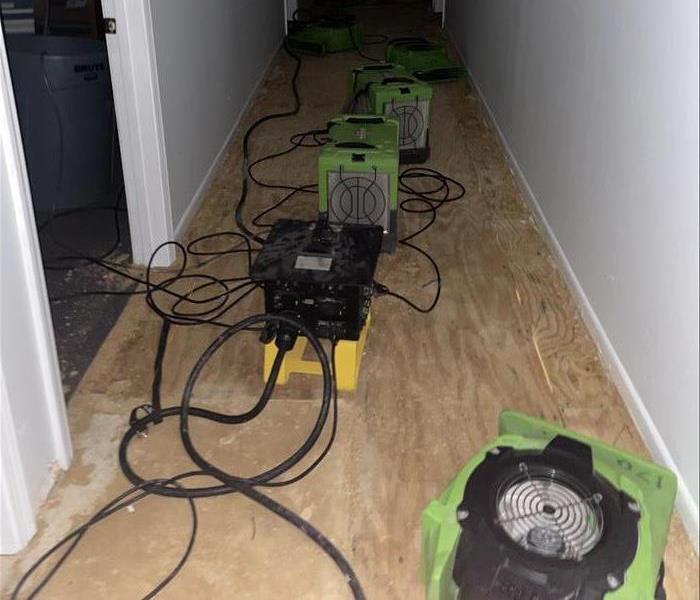 SERVPRO water damage experts brought in to place drying equipment after a flood was endured.
SERVPRO water damage experts brought in to place drying equipment after a flood was endured.
Floods can be some of nature's most sudden and devastating events, leaving behind submerged homes, ruined belongings, and shattered spirits. When waters rise, feelings of hopelessness can mount, but with SERVPRO® on your side, flood damage becomes a challenge we face together, working to restore both property and peace of mind.
Why Trust SERVPRO with Flood Damage Restoration?
1. Immediate Action, Day or Night: Flooding waits for no one. Our 24/7 response ensures that as the waters recede, SERVPRO is there, rolling up sleeves and getting to work.
2. Skilled and Certified Technicians: Addressing flood damage requires specialized knowledge. Our team, trained and certified, brings expertise and experience to every project, ensuring effective restoration.
3. High-tech Equipment: Flooding can penetrate deep into structures. Our arsenal of advanced drying equipment, dehumidifiers, and water extractors ensure a thorough and rapid drying process.
4. Comprehensive Care: From initial water extraction to final repairs, SERVPRO offers an all-inclusive flood restoration service, streamlining the process for homeowners.
SERVPRO's Flood Damage Restoration Steps
1. Detailed Inspection: Understanding the extent of flood damage is crucial. Our team meticulously assesses affected areas, formulating a strategic plan of action tailored to each situation.
2. Water Extraction: With powerful pumps and vacuums, we remove standing water quickly, minimizing the potential for mold growth and structural damage.
3. Drying and Dehumidification: After water removal, structures and belongings still retain moisture. Our specialized equipment ensures deep drying, reaching places that seem out of reach.
4. Cleaning and Sanitizing: Floodwaters can carry contaminants. We thoroughly clean and sanitize all affected areas and belongings, ensuring a safe and hygienic living environment.
5. Restoration and Reconstruction: Whether it's replacing damaged drywall, flooring, or even large-scale reconstructions, we aim to restore your property to its pre-flood condition.
6. Guidance with Insurance: Dealing with insurance after a flood can be daunting. We document all damages and work closely with insurance providers, helping to facilitate a smoother claims process.
Floods can be overwhelming, but with SERVPRO's flood damage restoration services, you're never alone in the aftermath. Our commitment is to stand beside you, working tirelessly until every drop is addressed, every damage repaired, and every memory preserved. If floodwaters threaten your sanctuary, remember SERVPRO – dedicated, proficient, and always ready to turn the tide.
How to Check Your Home For Water Damage and Who to Call for Water Damage Restoration
9/11/2023 (Permalink)
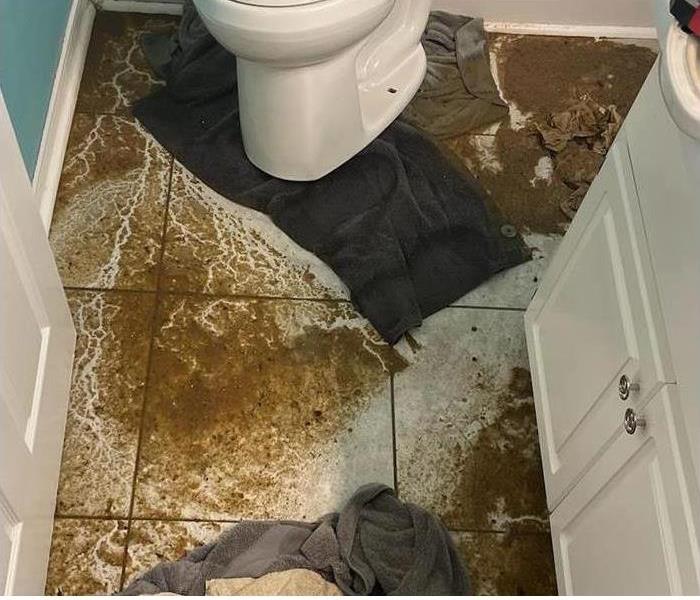 SERVPRO crew called in after toilet overflow causes severe water damage.
SERVPRO crew called in after toilet overflow causes severe water damage.
In general, a house is one of the biggest investments you will make in your lifetime. In order to protect that investment, you should vigilantly look out for household problems and address them before they worsen.
One such dreaded homeowner issue is water damage. If left unattended, residential water damage can detrimentally impact the structure or spawn other complications, including mold that poses a health risk to inhabitants. Here are several methods for detecting water damage within your house.
1. Check the Floors
No matter what kind of flooring you have, it will manifest signs of water damage. For tile and wood, look for cracked, buckling or warped flooring. When it comes to carpet, be wary of damp spots, gradual rises, soft spots or the smell of mold and dampness.
2. Look for Stains
Water stains on the floor around the bathtub, toilet or sink, as well as stains on ceilings and walls, are some of the most obvious signs of water damage. Unusual stains could indicate there is a leaky pipe or drain inside the wall. Cracks in the drywall or areas that appear swollen and are soft to touch also may signify trouble. Peeling paint is another sign of loose water within wall spaces. As the drywall gets saturated, paint can lose adhesion.
3. Inspect Outside
Observe the exterior of your house. What you want to look for are pools of standing water that can indicate poor drainage in the yard, gutter spouts that aren’t transporting water far enough from the house or leaky rain gutters. Any of those issues could threaten the foundation of your house. Additionally, common signs of water damage on the roof may include pools of water; cracked, curled or missing shingles; or broken flashing.
4. Watch for Rust and Mold
Inspect your water heater and check for rust on the tank or damp spots on the floor. A rusted tank could indicate a slow leak. Additionally, corrosion around pipe connections could be caused by water seepage. Visual signs of active mold growth mean moisture is contacting microscopic mold spores, often in the nooks and crannies of your home. Finally, don’t rely solely on sight. When water stagnates, mold and bacteria can grow, producing a musty, unpleasant smell.
What is all this equipment for?
1/3/2022 (Permalink)
You just called SERVPRO of Maitland-Casselberry. A disaster has struck you and your home or office. The crews from SERVPRO are on their way to mitigate the disaster. They show up in the big green trucks and in moments are assessing the damage to your property. Popping open the back of the truck they start to unload equipment, but what are they unloading? Why is it important? Here’s a list of the usual things you’ll see brought into a property once the team starts to work.
- Air Mover and/or Axial Fan: Professional grade air movers and axial fans produce more air movement than a standard household fan. The higher volume of air being moved increases the rate of evaporation, helping to dry the structure as quickly as possible.
- Dehumidifier: A dehumidifier removes water vapor from the air by condensing it out against refrigerated fins. The water is stored and then periodically purged from the machine by use of plastic tubing. The tubing will generally be run so that it dumps water down a drain, such as a bath tub or sink, or sometimes out a window or door. Professional dehumidifiers pull much more vapor from the air than a household dehumidifier. In this way they are generally more efficient.
- Air Scrubber: An air scrubber might be used if your loss is a result of water classified as grey or black, which means that it came from a contaminated source or through building materials. These machines remove airborne particulates by trapping them in HEPA filters. Air Scrubbers are also used in cases where a customer has a health condition that requires the air quality be monitored.
- Specialty Drying Equipment: There are a variety of different tools available to our technicians for use in specialty circumstances. For instance, a floor drying mat system allows the technician to create a vacuum system for removing moisture from hardwood floors, in order to try to dry them in place. This helps the floor dry faster, and generally gives us a better chance of saving the hardwood flooring.
There are of course many other tools you may well see if the situation requires them. The onsite SERVPRO technicians can and will explain any of the tools they use for the job. So when in doubt ask them!
How Water Damage Claims Work
12/28/2021 (Permalink)
Lets set a scenario and say that you're in your home in Maitland, FL and you've had a significant water damage. Multiple rooms are flooded, there is water coming out of your light fixtures downstairs, and then only thing you've been able to do it turn the water to stop the leak. What do you do next? Who do you call?
The good news is that you've turned off the water, so you have started the process of mitigating your loss. The following are some steps you can take to prevent secondary damage from occurring to your belongings while you wait for SERVPRO to arrive.
- Call SERVPRO so that we can send a technician to your site immediately.
- Contact your insurance company (if you haven't already) to report the loss and notify them that you have contacted SERVPRO and that we are in-route.
- Begin removing excess water by mopping and blotting. You can use a wet vac to suction as much water as possible as well.
- Remove and prop up wet upholstery cushions for even drying
- Place aluminum foil or wood blocks under furniture legs
- Hang furs and leather goods separately at room temperature
- Remove Oriental or other colored rugs from wet carpeting
- Do not use a household vacuum to remove water
- Do not turn on ceiling fixtures if the ceiling is wet, and keep out of areas where ceilings are sagging from retained water
- Do not leave books, magazines, or other colored items on wet carpeting
We our technicians arrive on site they will access the damages and being extracting water from porous surfaces. They will also place equipment and explain the drying process. If you have questions at any time during the process of drying your home or business, please call us at 407-388-0404.
Do's and Don'ts of Water Damages
10/14/2021 (Permalink)
“I have a water damage in my home. Can you help me?” No homeowner wants to make that call, but it unfortunately happens to many. Once you’ve made the call to SERVPRO of Maitland-Casselberry, what can you do?
Thankfully our staff is trained to walk you through the job process and offer some tips you can use to help mitigate your loss while you wait on our crews to arrive. Here is a list of some of do’s and don’ts that might also help.
DO:
- Shut off the source of water if possible or contact a qualified party to stop the source of water.
- Turn off circuit breakers for wet areas of the building when access to the power distribution panel is safe from electrical shock.
- Remove as much excess water as possible by mopping and blotting.
- Wipe excess water from wood furniture after removing lamps and tabletop items.
- Remove and prop up wet upholstery cushions for even drying.
- Place aluminum foil or wood blocks between furniture legs and wet carpeting.
- Remove to a safe, dry place any paintings, art objects, computers, documents and other materials that are valuable or sensitive to moisture.
- Use wooden clothespins to keep furniture skirting off damp floors.
- Hang draperies with coated hangers to avoid contact with wet carpeting or floors.
- Hang furs and leather goods to dry separately at room temperature.
DON’T:
- Enter rooms with standing water where electrical shock hazards may exist.
- Enter affected areas if electrical outlets, switches, circuit breakers or electrical equipment are exposed to water. Always avoid electrical shocks hazards.
- Leave books, newspapers, magazines or other colored items on wet carpets or floors to cause staining.
- Leave Oriental rugs or other colored rugs on wet wall-to-wall carpets to cause staining.
- Use your household vacuum cleaner to remove water, possibly causing electrical shock or damage to the vacuum cleaner.
- Use TV’s or other appliances while standing on wet carpets or floors, especially not on wet concrete floors.
- Turn on ceiling fixtures if ceiling is wet or enter rooms where ceilings are sagging from retained water.
Rest assured these tips will help you begin to mitigate your loss while our team of IICRC certified technicians is on the way. Please feel free to call us anytime at 407-388-0404.
We Find the Water You Can't See
10/14/2021 (Permalink)
Unfortunately water damage affects many homes and businesses each day. It’s the water you don’t see that causes the most damage. Many people are quick to mitigate what they can see. Towels and shop vacs soak up the water on your floor but what about the water you can’t see? The water that your insulation and drywall have soaked up? Who cleans that up? Who can even find it?
SERVPRO of Maitland-Casselberry has a highly trained water remediation staff on hand to help you during your time of need. Our crews will be on site to locate trapped water-in your walls, ceilings, below flooring-no matter where it is and to dry out your home properly. Our crews use state-of-the-art equipment to monitor the drying progress and insure that your home is back to normal, “Like it never even happened.” Give us a call anytime at 407-388-0404.
10 Questions People Ask About Water Damages
5/27/2021 (Permalink)
- “Can’t I just put in some fans?” Fans help, yes, but are not the only part of the drying equation. Fans help to push the moisture from your walls, ceilings, and floors into the air, and our commercial dehumidifiers help to pull all that water out of the air. Through a formula known as Psychrometry we can determine how many air exchanges it will take to dry your home or business with the equipment we place. Thats some fancy math!
- “I’ll just rip up my flooring. Insurance will replace it.” Hold up, wait a minute! Often flooring can be dried in place and then cleaned after it is dry. It is more cost effective to do this than to replace flooring that is still in good condition. Ultimately saving claim funds is better for you and your insurance company.
- “Open the doors and windows to help it dry out.” We are begging you, PLEASE do not do this unless you are instructed to by a water damage professional. If you live in a climate that is humid (hello Central Florida, looking at you) it is going to be more detrimental than helpful. The goal is to dry your structure, the natural humidity is going to make that worse. In fact, it would be better to turn your AC down so that it stays on until we get there with commercial equipment to begin drying.
- “UGH, this equipment is so HOT and so LOUD! I’m turning it off because I can’t sleep, work, or think!” You aren’t wrong. It is loud. It is hot. And it does make work, sleep, and even thinking hard to do. We PROMISE that if you stick with it and allow the equipment to do its job your home or business will dry much faster than if you turn it off and it only gets to work in small increments. Also, turning equipment off and allowing moisture to stay trapped will potentially lead to microbial growth (yep MOLD). I can promise you that 5 days of drying equipment is better than 10 days of mold remediation…not to mention that improperly handling your water damage can open issues with coverage for your claim with your insurance company. Trust me, it’s worth it to leave the loud, hot equipment on.
- “I thought you said you were getting paid by the insurance company. Why are you sending me a bill?” Our company works with all insurance companies. That being said, as the policy holder YOU are the one that the insurance company will send payment to (about half of the time). You will then need to forward payment to us. We do submit billing to the insurance company for you and we do work with your adjuster to close out payment for our services. We will also do our best to help you through the claim process. Ultimately, as the homeowner, or business owner, it is up to you to make sure payment is received for services rendered. If your insurance company determines that your loss is not covered by your policy you will be responsible for payment. We will always do our best to work with our customers if this is necessary.
- “I heard it only takes 3 days to dry out a house.” While it is true that many homes can be dried in a few days every structure is different. There are MANY unforeseen circumstances that can affect drying time. There are certain “best practices” that we adhere to for drying that help ensure timely progress. We also perform moisture inspections daily during a dry-out. This allows us to reposition equipment if we need to, remove equipment from areas that have dried, and to make sure that we are watching progress of anything that may require additional help.
- “I’m paying for this myself, so please don’t charge me what you charge an insurance company.” Our industry uses a couple of different software platforms for estimating/breaking down a job. Those platforms set the pricing. Insurance companies also use these systems, but the pricing is not “for” the insurance company. They’re getting the same pricing as you!
- “Who trains you?” The IICRC-Institute of Inspection Cleaning and Restoration Certification-is who we are certified and trained by primarily. (Here is the link to the about section of their web site https://www.IICRC.org/general/custom.asp?page=AbouttheIICRC). Any time you need a restoration professional you want to verify that they are a certified firm. You can do this by checking the IICRC site or asking for a copy of the firm’s certificate. Aside from the professional training by the IICRC, we offer in house training as well as additional training from other industry organizations.
- “Who is paying the power bill after you leave all that equipment plugged in?” We suggest that you reach out to your assigned insurance adjuster and ask if this is something that your policy will cover. In some cases, they need to see your bill for the month before and the month after, to show that there was an increase in usage. However, thanks to technology advancements, unless you’re dealing with a large amount of equipment for a long time, I doubt you’ll notice too much of a difference.
- “All of you water damage companies are the same”…. I beg to differ. This is personal for us. We are all here because we want to help. We know that having your home or business turned upside down is stressful. Unfortunately for most people, LIFE is stressful these days. Add a water damage to the mix and it’s almost more than anyone can take. We are here to help you through that. Not only do we care, but our company has been in business over 35 years! There just aren’t that many companies in our industry that can say that. Know why? The industry isn’t THAT old. It’s only been since people started having things like air conditioning, drywall, hot water heaters, appliances, and double paned windows that there was a need. Our industry is constantly growing and changing, and we are proud to have been at the forefront of that growth for so long.
Top Spring Flooding Tips
5/5/2021 (Permalink)
 Flood insurance is a must here in Florida, have you checked your policy lately?
Flood insurance is a must here in Florida, have you checked your policy lately?
Although flooding can happen at any time in Florida, Spring flooding is common as frequent storms leave the ground soaked and streams are often at their highest levels of the year. Here are some tips for both families and businesses.
- Make a family emergency communication plan and include pets.
- Have emergency supplies in place at home, at work, and in the car.
- Flood insurance takes 30 days to take effect, so purchase now to protect your family!
- Listen to local officials by radio, TV or social media.
- Evacuate when advised by authorities or if you are in a flood or flash flood prone area.
- If you are on high ground above flooded areas, being prepared to stay where you are may be the best protection.
- Don't let your business end up in a dumpster. Make a Flood Safety plan today.
- Charge mobile devices. Locate flashlights & radio. Tell friends/family your location in case of power loss.
- Heavy rain to areas that have been experiencing drought can cause flash flooding.
If you do need to venture out during or immediately after a flood, follow these rules:
- Don’t drive or walk through flood waters
- Water moving at just 5 miles per hour can lift and displace manhole covers leaving unseen dangers
- As little as 12 inches of moving floodwater can be enough to float and carry away a small vehicle.
- 6 inches of moving water can knock an adult off their feet. STAY AWAY from moving water!
- Driving thru 6 inches of standing water can cause vehicles to lose control & stall. Avoid flooded roads.
- Be aware of areas where waters have receded. Roads may have weakened & could collapse under the weight of a vehicle.
Personal Property
- 30: The number of days it takes for flood insurance to begin. Don’t wait until it’s too late!
- Only flood insurance will cover the damage from floods. Speak with your insurance agent to learn more.
- A few inches of water in a 1,000-square foot home could cost more than $10,000 in repairs & replacement of personal possessions
- Prepare for a flood today by reviewing your property & flood insurance policies.
- Snap some pictures of your property & do an inventory. This will be handy if flood waters damage your property. Again, consider using the SERVPRO Ready Plan App.
- Flood waters can damage important papers. Store critical docs in a waterproof container or electronically.
- Before a flood: reduce potential property damage by elevating utilities & installing sewer backflow valves.
- Prepare before a flood by installing a water alarm in your basement.
After a Flood
- Watch your step! Flood waters often hide sharp and dangerous debris like broken glass and metal!
- Wear the appropriate protective clothing and gear like boots, gloves and safety glasses when it comes to moving debris!
- Hands off! Stay away from electrical utility equipment after a storm or if it is wet to prevent being electrocuted!
- Flooded homes are hazards! Get a professional to check for loose wires, mold and hidden damage before re-entering!
- Avoid walking in floodwater. It can be contaminated with oil, gasoline, or sewage.
- Use generators or other gas powered machinery only outdoors and away from windows.
The team at SERVPRO of Maitland/Casselberry has specialized training and experience in fire restoration services, natural disaster prevention, water damage, and natural disaster cleanup. Our staff is highly trained in building services and property damage restoration. We study IICRC standards and best practices in cleaning and restoration.
Call SERVPRO of Maitland/Casselberry (407) 388-0404 anytime.
Casselberry Hidden Water Damages
11/27/2020 (Permalink)
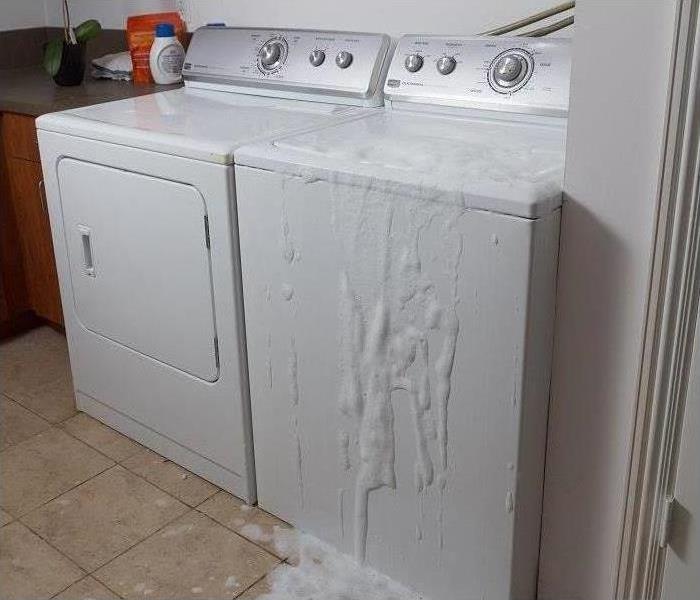 Washing Machine Malfunctions Can Cause Water Damage
Washing Machine Malfunctions Can Cause Water Damage
Think about the last time your appliances were moved or inspected
Many of us do not think about the household appliances that we use every single day. For most, they probably become a passing thought about how much wear and tear they are receiving. Most of the appliances we use to make our everyday lives easier to utilize water. This means they are prone to leaks at some point if they are not caught early on. Water damage can sit for ages before you as a homeowner realize. Therefore, regular inspections are important for prevention.
Inspect These Appliances for Leaks Often
- Hot Water Heater
- The lifetime of a hot water heater will typically span 10 to 15 years, but leaks can start much earlier than this. The seals and pipes connected to the hot water heater can often break down, so keeping an eye out for any accumulation both during and after use is a smart move.
- Refrigerator
- The rarity with which refrigerators are moved can lead to secret water damage that festers for ages before it is brought to light. A refrigerator’s water lines are typically made from a soft plastic that can easily fail, so checking for leaks behind and under the fridge as part of your annual home maintenance is wise.
- Dishwasher
- A dishwasher’s tubing is just as problematic as a refrigerator but is even more isolated and utilizes far more water. Additionally, homeowner’s insurance often does not cover water damage caused by older models of dishwashers, so regular checks are extremely important to keep up with.
- Washing Machine
- Washing machine hoses are some of the most common sources of leaks. Because they are notorious for this, it is recommended that they are inspected at least once a month by homeowners so you can be sure no issues have arisen. In addition to these regular checks, they should be fully replaced every five years in order to prevent hidden deterioration.
- Air Conditioner
- The drain in your HVAC unit is designed to keep condensation from pooling in and around the unit, but if this drain malfunctions, water damage can quickly be caused. Reference your manufacturer’s manual to determine how often your unit should be inspected and serviced—having a professional technician evaluate your machine is the best defense against HVAC-created water damage.
How Do I Choose a Company to Clean Up Water Damage?
11/6/2020 (Permalink)
 SERVPRO Cleans Up and Restores Water Damaged Clearwater Properties--While Working within Insurance Guidelines
SERVPRO Cleans Up and Restores Water Damaged Clearwater Properties--While Working within Insurance Guidelines
SERVPRO brings decades of experience and the latest in restoration techniques to local Orlando Area properties in need
It seems the most inconvenient times are when hot water tanks fail, toilets back up, pipes burst, or that leak in the roof happens. When you need water cleanup in your Maitland home, the key is to begin as soon as possible with the extraction and drying. Some of the key elements to look for when choosing a local restoration services company are:
- Ask about water-restoration related certifications
- Find out about the equipment that gets used
- Will the company work with your insurance carrier?
- Is there a policy to inhibit out-of-pocket charges by working within the scope of coverage?
- Does the company have access to professional-grade cleaning agents, antimicrobials, and antibacterial solutions?
Can Water Damage Restoration Companies Do Repairs As Well As Cleanup?
When choosing among local water restoration companies in the Orlando Area, you already know the necessary information to ask about. Getting repairs done after the water removal and drying of the structure makes the whole process seamless. With their general contractor license #CBC1258985, SERVPRO technicians can handle any needed repairs or reconstruction to every part of your home. Commonly needed repairs the technicians provide include:
- Replacement of sheetrock on walls and ceilings
- Installation of tile
- Refinishing or replacement of hardwood floorboards
- Painting and other cosmetic services
The technicians work to save homeowners the cost of repairs and replacement whenever possible. The use of equipment such as an infrared camera to identify water location assists in assuring that no moisture gets left behind. Other sensitive moisture detectors and hygrometers help the techs measure the amounts of moisture saturation throughout the home. Once they pinpoint all the locations, they can use their powerful extraction equipment to remove the majority of the water. Even if the water in the home is several inches deep, they have the equipment to handle it.
Special Water Damage Situations
When the water contains sewage, chemicals, or other harmful elements, the techs have training and experience handling biohazard-level cleanup jobs. The job entails wearing protective gear, and most importantly, respiration equipment aspirating water vapor can prove harmful. There are different types of containment, such as simple barriers made from heavy gauge plastic sheeting or setting up negative air chambers, both methods work to inhibit the potential for cross-contamination.
Floodwater from heavy storms or hurricanes is part of living in this part of the state, and it is crucial to work with a restoration services company that has the experience of dealing with this type of damage. This type of water intrusion event frequently needs controlled demolition. Sheetrock deteriorates rapidly and sagging ceilings or buckling walls can present safety hazards and require removal. The techs remove only the damaged portion and leave the rest of the structure intact to limit the amount of rebuilding needed to restore the home.
Removing Mold from a Maitland, FL Property?
In short, it is impossible to remove naturally occurring airborne mold spores that are floating harmlessly both indoors and outdoors. However, when the conditions in your home become right in terms of a damp area with temperatures that sustain growth, you can have a spreading mold infestation in your home. Once mold establishes itself, it will not go away on its own and should have professional remediation to halt the process. The techs will also investigate and find out the reason for the mold growth and suggest remedies to stop the situation from continuing.
SERVPRO technicians have comprehensive training and certification to handle mold remediation #MRSR868 in your home. They carefully contain the area to prevent any spread of the spores to other areas of the house and dry the existing colonies. Afterward, they remove the dry matter using manual methods or automated techniques such as soda or ice blasting to remove the dried mold without marring the surface it is on.
Once the structure gets dried and treated for any mold issues, the technicians focus their attention on any remaining residual water odors. The distinctive musty smell can get removed through the use of deodorizing cleaning agents, the use of gel pellets, or more robust methods such as thermal fogging or hydroxyl generators. The techs choose the appropriate method based on the level of scent control needed in the home.
SERVPRO of Maitland / Casselberry at (407) 388-0404 is proud to serve the local area as one of the premier water restoration companies. Their trained, certified technicians are available 24/7 and arrive quickly on site. The techs work diligently to return your home to tiptop shape.
Most Common Causes of Water Damage in Your Maitland Home
8/3/2020 (Permalink)
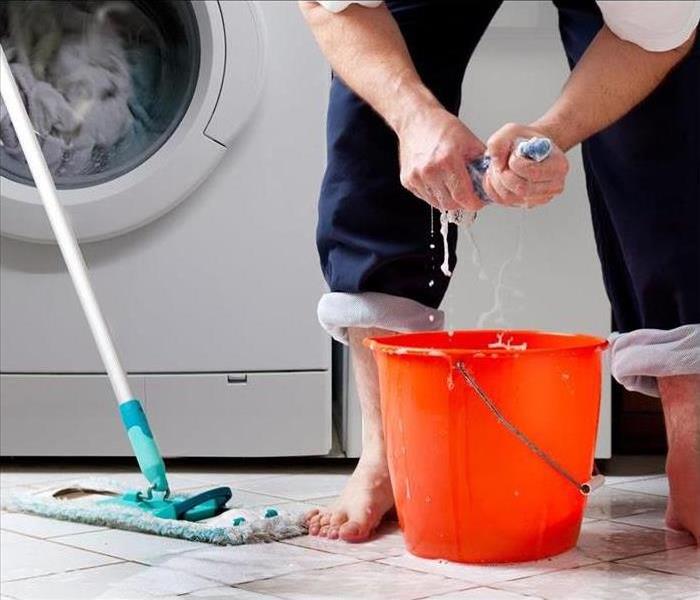 At SERVPRO, our water damage specialists have the experience, expertise, and equipment to restore your property quickly and efficiently.
At SERVPRO, our water damage specialists have the experience, expertise, and equipment to restore your property quickly and efficiently.
Water damage in a residential property is often caused by things like water leaking or flooding that goes unnoticed for a long period of time. Damage of all kinds can wreak havoc on your property when excess water starts to pool in an area of the home. Unfortunately, most homeowners are unaware of the signs and warnings of water damage and therefore leave the issue unresolved, eventually causing further damage. Water damage restoration is the process of removing the water, drying and dehumidifying, clean and sanitizing, and then restoring the area to its original state. From minor repairs to carpet replacements, identifying water damage early is the key to minimizing potential damage to your home.
The ability to recognize signs of water damage is the first step in keeping your property in top condition. As such, it is important to understand the most common causes of water damage in your home. They are as follows:
- Leaking pipes, bursting pipes, or broken hoses
- Malfunctioning air conditioners or other HVAC issues
- Broken dishwashers, washing machines, or other household appliances
- Sewer backup, clogged drains, or general plumbing problems
- Water buildup in areas like attics or crawl spaces
- Natural disasters like hurricanes or rainstorms that cause flooding
- Running toilets
- Bathtub overflows
- Malfunctioning fire sprinkler system
No matter what the water damage cause may be, addressing the problem immediately is imperative to reducing damage and restoring the area back to optimal condition. At SERVPRO, our water damage specialists have the experience, expertise, and equipment to restore your property quickly and efficiently. From floods to leaking pipes, our water removal and cleanup process will make your home look “Like it never even happened.” Contact our office as soon as possible to learn more about how our Disaster Recovery Team can help you and your home today!
How to spot water damage
8/3/2020 (Permalink)
In general, a house is one of the biggest investments you will make in your lifetime. In order to protect that investment, you should vigilantly look out for household problems and address them before they worsen.
One such dreaded homeowner issue is water damage. If left unattended, residential water damage can detrimentally impact the structure or spawn other complications, including mold that poses a health risk to inhabitants. Here are several methods for detecting water damage within your house.
1. Check the Floors
No matter what kind of flooring you have, it will manifest signs of water damage. For tile and wood, look for cracked, buckling or warped flooring. When it comes to carpet, be wary of damp spots, gradual rises, soft spots or the smell of mold and dampness.
2. Look for Stains
Water stains on the floor around the bathtub, toilet or sink, as well as stains on ceilings and walls, are some of the most obvious signs of water damage. Unusual stains could indicate there is a leaky pipe or drain inside the wall. Cracks in the drywall or areas that appear swollen and are soft to touch also may signify trouble. Peeling paint is another sign of loose water within wall spaces. As the drywall gets saturated, paint can lose adhesion.
3. Inspect Outside
Observe the exterior of your house. What you want to look for are pools of standing water that can indicate poor drainage in the yard, gutter spouts that aren’t transporting water far enough from the house or leaky rain gutters. Any of those issues could threaten the foundation of your house. Additionally, common signs of water damage on the roof may include pools of water; cracked, curled or missing shingles; or broken flashing.
4. Watch for Rust and Mold
Inspect your water heater and check for rust on the tank or damp spots on the floor. A rusted tank could indicate a slow leak. Additionally, corrosion around pipe connections could be caused by water seepage. Visual signs of active mold growth mean moisture is contacting microscopic mold spores, often in the nooks and crannies of your home. Finally, don’t rely solely on sight. When water stagnates, mold and bacteria can grow, producing a musty, unpleasant smell.
Minimize the Chance for Insurance Claims at Your Casselberry Business
7/22/2020 (Permalink)
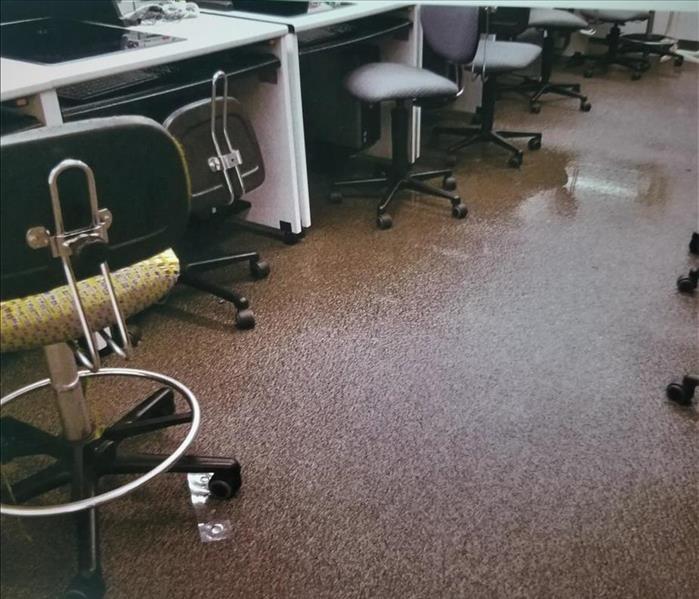 Burst pipe in a chilled water system flooded this Lab.
Burst pipe in a chilled water system flooded this Lab.
It's a good idea to have a life preserver and lifeboat when you are on a cruise, but you probably don't want to use them. The same is true of commercial property insurance for your company in Casselberry, FL. If you need it, it is there to pay out a business claim for such things as water damage, but it is worthwhile to take action to prevent damage in the first place. One area that has the potential to cause problems is your plumbing system. Even a small business is likely to have hundreds of feet of pipes. Some of these pipes are accessible, while others are underground or behind walls.
Ways To Avoid a Business Claim
A few precautions with your plumbing system can reduce your likelihood of having to file a claim in this area. These basic steps can go a long way toward protecting the integrity of your plumbing system:
- Educate employees on where, how and when to turn off the water supply
- Maintain plumbing systems to prevent a pipe break
It is always easier and less expensive to avoid a problem in the first place. You won't have to deal with wet carpeting, contaminated water, mold issues, and other water damage concerns.
Ways To Minimize a Business Claim
If your company does experience water problems, immediate action by a storm remediation franchise is your best source to limit damage and shorten a business interruption. A local company that works 24/7 and 365 days a year can get to work before mold growth or other problems have time to increase. Fast water removal and extraction limit the corrosive power of water to break down materials and cause lasting damage. By using the highest standards of the cleaning and restoration industry, a professional company reduces your exposure to expensive claims.
SERVPRO of Maitland-Casselberry is proud to serve the Maitland, Casselberry, Union Park, Lockhart, Fern Park, and surrounding communities.
I Need Water Removal Services in Maitland/Casselberry? Can I Contact The Experts at SERVPRO?
5/19/2020 (Permalink)
 Ready to mobilize at a moments notice in Maitland/Casselberry.
Ready to mobilize at a moments notice in Maitland/Casselberry.
We Have Expert Solutions to Help With Your Water Damage.
After the removal of pooling water, what is left behind can be unpleasant to look at or even release bad smells. Getting rid of staining and soiling can go beyond the scope of household cleaning products in which case you need professional help. We have built our reputation on the removal, remediation and cleanup of water all over the United States. We stick to a few simple principles that have served us well.
The immediate impact of water damage in Maitland/Casselberry properties is usually taken on by the infrastructure of the home. Subfloor mats that become saturated with moisture can quickly become hotbeds for bacteria and fungi. Equally, wall cavities or furniture fittings can take on moisture undetected to the naked eye causing long-term problems. SERVPRO are experts at spotting potential problem areas that may have slipped your notice.
As a local company, we can provide qualified water technicians reducing call out times. As a national franchise, we are able to mobilize state-of-the-art equipment to help rehabilitate your property and possessions. One of the most important methods in restoring water damages is allowing airflow into wall cavities. Properties that take on moisture in pockets with minimal airflow can quickly become stagnant and produce unwanted smells or appearance.
SERVPRO can bring injectidry systems to your property to remove moisture that may be stagnating in wall cavities. These advanced equipment use a series of injectors spaced four inches apart to blast hot air rapidly into cavities or underneath fittings and dry them. One of the benefits of injectidry systems is that they remove the need to replace large sections of drywall. In most cases, sheetrock can be thoroughly dried using this equipment rather than having to be removed or replaced.
Discoloration is a common side effect of paintwork that is exposed to excessive amounts of water for a prolonged period. SERVPRO can repaint the affected area using an antimicrobial base layer. Applying antimicrobial treatments to carpets, paintwork or possessions is an essential part of the water remediation. Doing so can significantly reduce the risk of secondary damages, and expenses, caused by mold or mildew growth.
A professional solution is best left to the water damage experts, contact SERVPRO of Maitland/Casselberry at (407) 388-0404 for assistance.





 24/7 Emergency Service
24/7 Emergency Service
